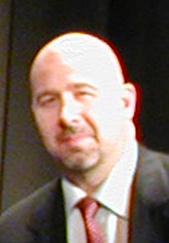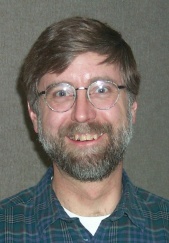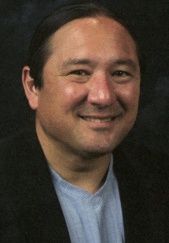The
UK Chapter of the Eurographics Association (EGUK)
presents:- |
|
Theory
and Practice of Computer Graphics 2006 |
|
University of Teesside, Middlesbrough, UK |
|
Conference
- Prof Marc Cavazza
- Prof Charles Hansen
- Prof Stuart Sumida
|
University of Teesside
|
"AI-based Interactivity" Abstract Artificial Intelligence techniques have been only marginally relevant to computer graphics. In computer games, elementary AI techniques have been used for character behaviour, but the environment behaviour has remained under the control of scripted procedures or generic Physics engines. Virtual Reality systems have rarely incorporated AI techniques, apart from camera control and some natural language interfaces. Yet, a closer look at the frameworks underlying interactivity in many graphics systems shows the prevalence of discretised behaviour relying on event-based systems. This talk will explore the potential of state-of-the-art AI techniques, such as Qualitative Reasoning, to support behaviour of 3D graphics worlds. The long-term endeavour consists in re-introducing semantics in computer graphics worlds, whose formalisms have been originally developed from the exclusive perspective of real-time visualisation. |
Biographical Sketch Marc Cavazza is Professor of Intelligent Virtual Environments at the University of Teesside. His principal research interest is the use of Artificial Intelligence techniques for Virtual Environments. His most recent research projects were in Interactive Storytelling and the development of AI-based behavioural techniques for Virtual Environments. He has published over 150 refereed papers in the fields of Human-Computer Interaction, Virtual Reality and Artificial Intelligence. He has been an expert for the European Commission on the Information Society Programme continuously for the past ten years, for several Directorates. From 2002 to 2005, he was co-ordinator of the “ALTERNE” Project (www.alterne.info), one of the largest EU-funded projects on Virtual Reality Art. He is now principal investigator at Teesside for the DTI Technology Programme “BARDS” project on Interactive Storytelling, in partnership with Eidos Interactive plc. He serves on the programme committee of numerous conferences on intelligent agents and intelligent graphics, including ACM AAMAS 2006, ACM ACE 2006, Intelligent Virtual Agents 2006, the IFIP International Conference on Entertainment Computing, and Smart Graphics 2006. |
Prof Charles HansenSchool of Computing and the Scientific Computing and Imaging Institute, University of Utah
|
"Large-Scale Scientific Visualization" Abstract Computers have changed the way we live, work, and even recreate. Now,
they are transforming how we think about science, engineering, and
medicine. Advances in computational modeling, imaging, and simulation
allow researchers to build and test models of increasingly complex
phenomena and thus to generate unprecedented amounts of data. These
advances have created the need to make corresponding progress in our
ability to understand large amounts of data and information arising from
multiple sources. Although these machines offer enormous potential for
solving very large-scale realistic modeling, simulation, and
optimization problems, their effectiveness will hinge upon the ability
of human experts to interact with their computations and extract useful
information. In fact, to effectively understand and make use of the vast
amounts of information being produced is one of the greatest scientific
challenges of the 21st Century.
|
Biographical Sketch Charles (Chuck) Hansen is Professor of Computer Science and an Associate Director of the Scientific Computing and Imaging Institute at the University of Utah, USA. His research interests span scientific visualization, computer graphics, and high performance computing. Scientific visualization of large scale
problems is of key interest and recent work involves taking into consideration time-varying data and exploiting this for speeding up the Prof. Hansen has been Associate Editor-in-Chief for IEEE Transactions on Visualization and Computer Graphics since August 2003 and guest editor in IEEE Computer Graphics and Applications. Beside having served as a member of Executive committees and program committees on a large number of International conferences, including IEEE Technical Committee on Computer Graphics, 2004 EUROGRAPHICS Workshop on Parallel Graphics and Visualization, IEEE Visualization and SIGGRAPH, his professional activities also include being Co-chair of IEEE Visualization 2000 and IEEE Visualization 2001 as well as a founding co-chair of IEEE Symposium on Parallel Visualization and Graphics, and is currently a Short Papers Co-Chair for Eurographics 2006, Vienna Austria. |
Prof Stuart SumidaCalifornia State University, San Bernandino
|
"Anatomy, Animation, Science, and Special Effects - Biology meets Computer Graphics" Abstract The future of biomedical imaging, the power to influence with story-telling, the synthesis of art and science – they can all find seeds in animation. Professor Stuart Sumida has consulted on animated characters and digital effects for over thirty length feature films for such groups as Walt Disney Feature Animation, DreamWorks and Pacific Data Images, Warner Brothers, Rhythm and Hues, SONY Pictures ImageWorks, Walt Disney Imagineering, and others. Based on these experiences, and his work as an animal and human anatomist, he will discuss the relationships between the science of anatomical structure and the art and science of animation as they relate to computer graphics. Standard features of animal anatomy and feeding will be presented in regards to how they impact on body design. In turn, this will focus on how such information is important to artists, designers, and riggers for the processes of both traditional and computer generated animation. Human design and function will also be reviewed with an eye toward features characterizing adults versus children (the "cutification factors") and female-male dimorphism. For both animals and humans, locomotion and movement in general will be emphasized.
|
Biographical Sketch Professor Stuart Sumida received his Ph.D from UCLA in 1987, and taught in the Department of Anatomy and the Pritzker School of Medicine at the University of Chicago from 1988-1992, and moved to California State University San Bernardino in 1992. He is the author of three books and approximately 60 publications on the anatomy of living and extinct amphibians and reptiles - animals that predating the earliest dinosaurs by 50-80 million years. But, he works on dinosaurs as well, investigating their locomotion and relationships to birds.
|



